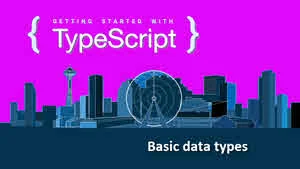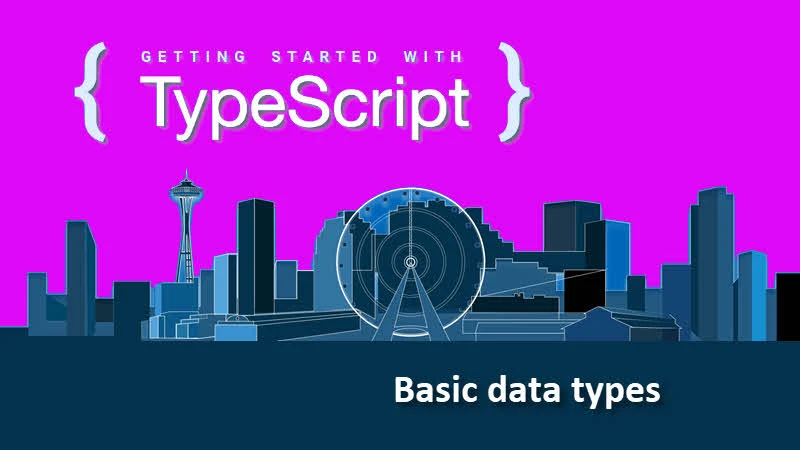Like JavaScript and any other languages, TypeScript also provides basic data types to handle numbers, strings etc. Some common data types in TypeScript are: number, string, boolean, enum, void, null, undefined, any, never, Array and tuple.
Let's learn more about these basic data types of TypeScript, which you will need to use always. Let's learn with suitable examples.


👉 TypeScript Tutorial - Getting started with TypeScript
Number types
In TypeScript, numbers are floating point values having the type as number. You can assign any numeric values including decimals, hexadecimals, binary and octal literals. But to use binary and octal literals, you must use a TypeScript version which follows ECMAScript 2015 or higher.
Here's some examples of declaring numeric values:
let decimalValue: number = 10;
let hexaDecimalValue: number = 0xf10b;
let binaryValue: number = 0b110100;
let octalValue: number = 0o410;
String types
When you want to use textual data, the string types are used and is denoted by the keyword string. Like JavaScript, TypeScript also uses double quotes (") and single quotes (') to surround the string value.
let firstName: string = "Kunal"; // using double quotes
let lastName: string = 'Chowdhury'; // using single quotes
When you want to span a string to multiple lines and/or have to embedded expressions (${expression}), you can use templated strings. The templated strings are surrounded by backquote/backtick (`) as shown in the below code snippets:
let firstName: string = "Kunal";
let lastName: string = "Chowdhury";
let message: string = `Hi, my name is: ${firstName} ${lastName}`;
let spannedMessage: string = `Hi,
My name is: ${firstName} ${lastName}`;
Boolean types
To use boolean data types in TypeScript, for declaring variables, use the boolean keyword. Here's a simple code to declare a boolean type variable:
let isPrimaryAccount: boolean = true;
let hasCards: boolean = false;
Enum types
Enumerated data types (enum) are a set of numeric values with a more friendly names. It's an addition on top of JavaScript that TypeScript offers. The variables of enumerated data types are declared with the keyword enum. Here's how you can declare an enum variable and use it in TypeScript:
enum CardTypes { Debit, Credit, Virtual }
let card: CardTypes = CardTypes.Debit;
By default the enum values start from 0 (zero), but you can also set it by manually entering the value of its members. Consider the following two examples:
enum CardTypes { Debit = 1, Credit, Virtual }
enum CardTypes { Debit = 1, Credit = 3, Virtual = 5 }
Void types
In general, this type of data types are used in functions that do not return any value. For example, function showMessage(): void { ... }. In TypeScript, you can also declare a variable of type void, but can only assign undefined or null to them. We will discuss about undefined and null types in the next points.
Null types
You can declare a variable of type null using the null keyword and can assign only null value to it. As null is a subtype of all other types, you can assign it to a number or a boolean value.
let nullValue: null = null;
let numericValue: number = null;
👉 TypeScript Tutorial - Getting started with TypeScript
Undefined types
You can use undefined keyword as data type to store value undefined to it. As undefined is a subtype of all other types, just like null, you can assign it to a number or a boolean value.
let undefinedValue: undefined = undefined;
let numericValue: number = undefined;
Any types
While writing code you are unsure of the data type of a value, due to its dynamic content, you can use the keyword any to declare the said variable. This is often useful when you are seeking input from user or a 3rd party library/service. This is also useful when you are declaring an array which has a mixed data type. It's just like the dynamic keyword available in C#. For example,
let dynamicValue: any = "Kunal Chowdhury";
dynamicValue = 100;
dynamicValue = 0b1100101;
dynamicValue = true;
let dynamicList: any[] = [ "Kunal Chowdhury",
"Free User",
21,
true
];
Never types
The never type represents the data type of values that never occur. For example, the following function that always throws an exception, can never return a value. Thus, the return type of the function can be set as never. Here's the function declaration:
function throwError(message: string): never {
throw new Error(message);
}
Array types
Just like JavaScript, you can work with arrays in TypeScript and can define it in either of the following two ways where the second approach is the more generic way to declare arrays:
let marks: number[] = [80, 85, 75];
let marks: Array<number> = [80, 85, 75];
Tuple types
Tuple is a data type that allows you to create an array where the type of a fixed number of elements are known but need not be same. While accessing an element of a Tuple with a valid known index, the data of correct type will be returned. In case you access an element outside the set of known indices, a union type will be used. Consider the following code snippet as an example:
// correct
let person: [string, number] = ["Kunal", 2018];
// error
let person: [string, number] = [2018, "Kunal"];
// correct
let person: [string, number] = ["Kunal", 2018, "India"];
// correct
let person: [string, number] = ["Kunal", 2018, 21];
// error
let person: [string, number] = ["Kunal", 2018, true];
👉 TypeScript Tutorial - Getting started with TypeScript
CodeProject






